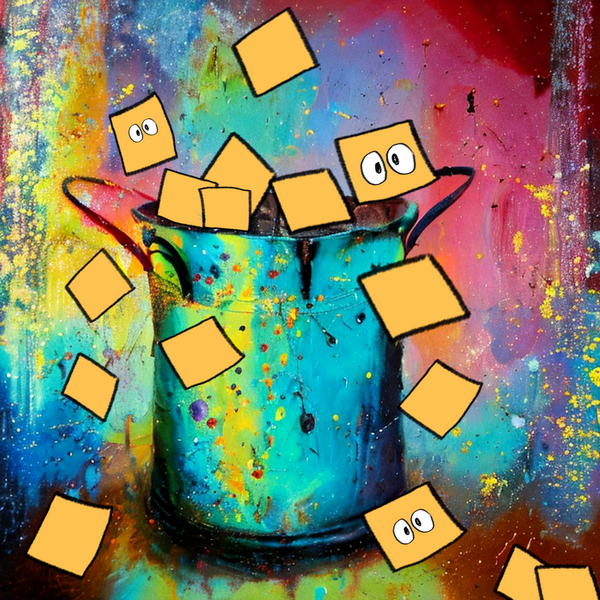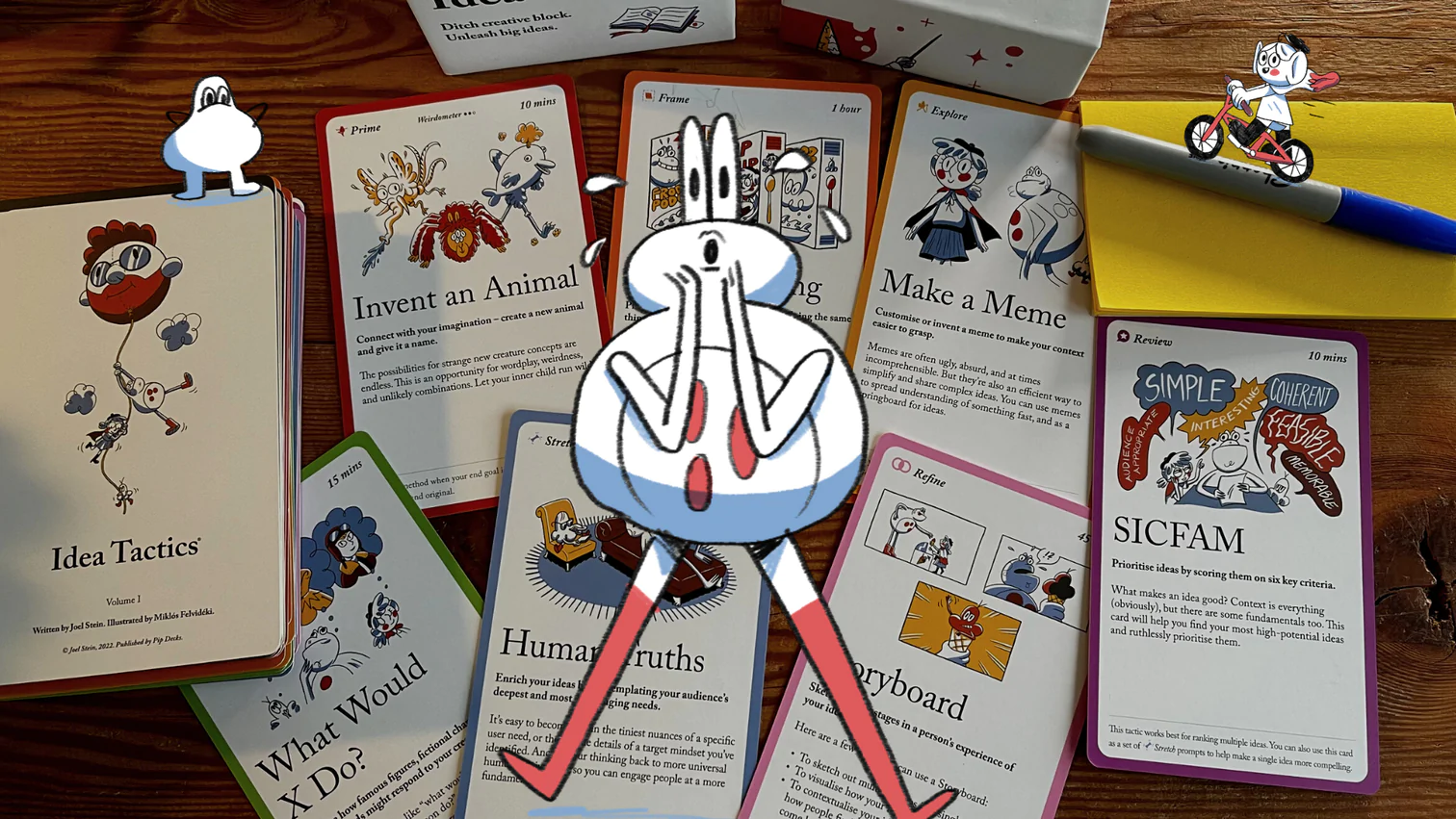So you’ve bought Idea Tactics, but you’re not sure where to start?
Don’t worry – this post will walk you through it, and point you to some other handy resources that might help.
Using Idea Tactics solo? Here’s a post that explains how you can use the cards for individual work.
New to facilitation, or just eager to improve? Here’s a post about the art of facilitating group sessions.
Getting acquainted with the Idea Tactics Strategy System

The Strategy System card is your GPS for the rest of the deck; it will help you figure out where you are in your creative process, and show you where to go.
Let’s dig a bit deeper into the six questions on the card…
Is your creative challenge crystal clear?
Einstein is quoted as saying “If I had an hour to solve a problem I’d spend 55 minutes thinking about the problem and five minutes thinking about solutions.”
In order to reliably generate valuable ideas, it helps to have a clear sense of the problem you’re hoping to solve, or a compelling summary of an opportunity you’ve spotted.
In order to answer “yes” to this question, you’d be able to point to something like:
- A well-written creative brief
- A unique “How might we…?”
- A key challenge/opportunity identified in your strategy
If you don’t have anything like that yet, use one of the Frame cards to create more clarity. How Might We? and Who, What, Where, Why are the simplest ones to start with.
If your creative challenge is already crystal clear, go to the next question.
Do you have thought-provoking material ready to inspire you?
‘Inspiration’ sometimes gets a bad rap because it can mean lazily borrowing other people’s ideas. That’s not what the Explore cards are about.
BUT, you do want relevant and interesting stuff that people can take inspiration from when it’s time for the actual ideas bit; if you just jump straight from framing your challenge to generating ideas, people usually get some blank-paper dread.

The Explore cards help in three key ways:
1. Expose the hidden insights in people’s heads
This is good for giving shape to your own thoughts, and great for maximising creativity in groups. Mind Map and Make a Meme are the best examples.
2. Get a better sense of the context you’re working in
If you’ve already done some research, maybe you have some data but don’t really know what it means. Observe/Infer can help. For learning from the mistakes of others, try Fame vs Shame.
3. Encourage tangential thinking
‘Going off on a tangent’ is something we often associate with poor mental focus, but when you’re in idea-generation mode, following weird paths is useful; a little randomness should be welcomed. Mind Map lets you capture some of these tangents in real time, and Combinaboards helps you find more unexpected connections.
If you’ve already got stimulating insights about the problem you’re working on, the audience you’re serving, or the space you’re operating in, you can jump to question 3 on the Strategy System card.
Do you already have some ideas?
Rick Rubin, legendary record producer and author of ‘The Creative Act’, says “if you need 10 of something, make 30. Then pick the best.”
He’s in good company. Linus Pauling, the father of molecular biology and the only person to have won two unshared Nobel prizes, said “the best way to have a good idea is to have a lot of ideas and throw away the bad ones.”
Whatever your challenge, having lots of ideas before you ditch the weak ones and double-down on the strongest is the best way to reliably end up somewhere great.

If your idea bucket is already overflowing, you can skip to the next question. Otherwise, the Diverge cards will help you have lots of ideas, week in, week out, to maximise your chances of finding the most precious gems.
If you’re new to this, try Worst Idea Race first to let go of any creative inhibitions, then try Lotus Blossoms to practise rapidly generating and evolving your ideas.
Do any of your ideas excite or surprise you?
It’s always good to remember that you are not your audience; you might love an idea that leaves them cold. But on the other hand, what chance is there that someone else will have their soul stirred by an idea that didn’t excite or surprise the person or team that came up with it?
And how brilliant will the execution be if there’s not a buzz around the idea as it’s taking shape?
You can just feel when creative acts are infused with joy and love – if something was loads of fun to work on, that manifests in the end product.
You can also feel when websites, adverts, blog posts, social content, and even big-budget films were just cranked out on autopilot by people that didn’t really give much of a shit.
So, before you develop and invest in an idea, it’s always worth asking yourself “am I excited by this?” and “does this subvert or surpass my expectations in some way?”
If you’re already answering with an enthusiastic “yes” based on an existing idea, brilliant – onto the next question. If not, the Stretch cards can help you push your ideas from meh to magnifique.
When in doubt, grab Human Truths and find a way to tap into something deep and universal.
Pro tip: You can also use Stretch cards with more fully developed ideas that come out of the Refine phase.
Have you described your most interesting ideas in detail?
Ever been in a workshop where someone’s idea seemed amazing at the time, but then you came back to make sense of a scribbly sketch with a couple of words next to it the following Monday, and you couldn’t remember what everyone was so excited about?
Whether you’ve been in that situation or not, the exercises on the Diverge cards aren’t designed to produce fully formed, fleshed-out ideas; they’re methods for getting lots of options down fast, so you can spend your time adding detail and depth to the most promising ones.
That’s where the Refine cards come in – they give you techniques for developing your ideas using words, sketches, stories, and comparative references. This makes them easier to share, easier to evaluate, and easier to break down when planning execution.
T-Bar and Mega Memo are both great methods for beginners.
Once you’ve captured your most interesting ideas in detail, you can move onto the final question.
Do you know what to prioritise?
Robust review and critique will help you strengthen your ideas and cut out anything that’s not essential.
But it’s important that you never enter crit-mode unthinkingly – it’s all too easy to squash fresh ideas before they have a chance to bloom and undermine the atmosphere of uninhibited, playful curiosity that makes creative breakthroughs possible.
That’s why Review activities live at the end of the Idea Tactics process, but as you get familiar with some of the other cards in the deck, you’ll see suggestions to use cards like Invest Your Pipcoins earlier in the process from time to time (like when you’ve got a bunch of ideas during your Diverge phase and you need to decide which to take forward).
SICFAM is another great card for ranking ideas. And Deep Impact is great for checking your blindspots.
What about the Prime cards?
Wherever the Strategy System card tells you to start, it’s always worth warming up with a Prime activity.
Prime cards are designed to get you ready to think creatively – they’re the ideation equivalent of getting your heart rate up and stretching your muscles before a workout.
These cards help:
- Foster a playful atmosphere
- Fire up people’s imaginations
- Increase levels of empathy and trust in groups
But they’re just as useful when working solo too.
Zen Spiral is super accessible for beginners. Draw Your Job is one I recommend again and again. And Haiku is deceptively powerful.
Try a five-day challenge
If you’re still feeling a bit overwhelmed by everything, or just don’t have a live problem you’re working on right now, I’ve put a few five-day challenges together to give you fun and easy ways to begin playing with Idea Tactics.
Five days of dreams
Card: Dream Sketch
Challenge: Record something you remember from a dream five mornings in a row.
Benefit: You’ll be more in touch with your subconscious, which will help you find your way to more interesting and unusual ideas.
A meme a day keeps the fluff away
Card: Make a Meme
Challenge: Each day, try communicating something that would normally be an email, a direct message, a presentation slide, or a Zoom conversation, as a meme.
Benefit: You’ll practise boiling your ideas down to something that can be understood in seconds. Bonus: You might make someone laugh.
What would VWXYZ do?
Card: What Would X Do?
Challenge: Reflect on a goal that’s important to you personally, or an obstacle you’ve been struggling to overcome. Over five days, imagine how five different people you admire would handle the situation.
Benefit: You’ll strengthen your divergent thinking muscle and maybe even find a helpful new perspective.
Still not sure where to start?
Don’t worry, you’re not alone. Come and join a whole community of idea-jammers in the Pip Decks Slack space.
Ask questions in the #idea-tactics channel and I’ll help in any way I can, along with the rest of our awesome community.
Stop procrastinating, start playing
There’s really no wrong way to use Idea Tactics.
It’s designed to be infinitely remixable, and everyone interprets each activity in their own unique way – we all arrive with different experiences, and work in different contexts.
Rather than worrying whether you’re doing it right, the best advice I can offer is to simply PLAY.
Think of this deck more like a box of LEGO than a Rubik’s Cube – explore the endless possibilities rather than racing to complete the puzzle.
And remember, your creativity is like a muscle. It gets stronger the more you use it, and looser the more you stretch it. Spend more time playing with ideas, and you’ll see what I mean.


If you leave us your email, we'll let you know if we update this guide based on your feedback.